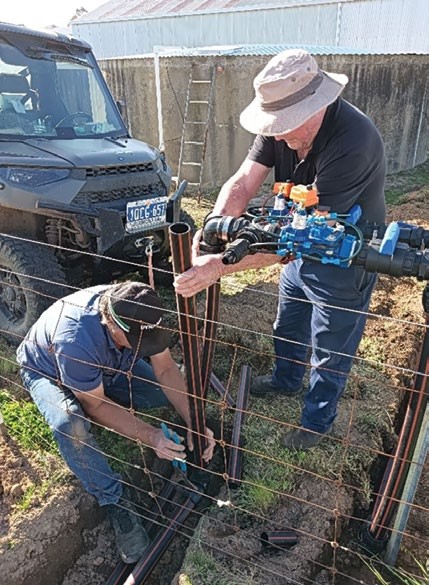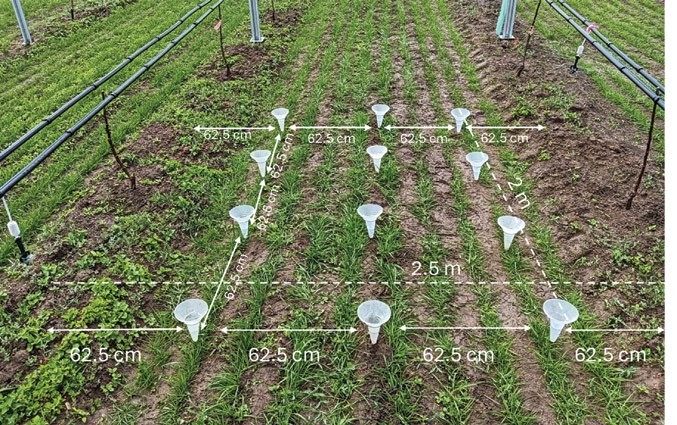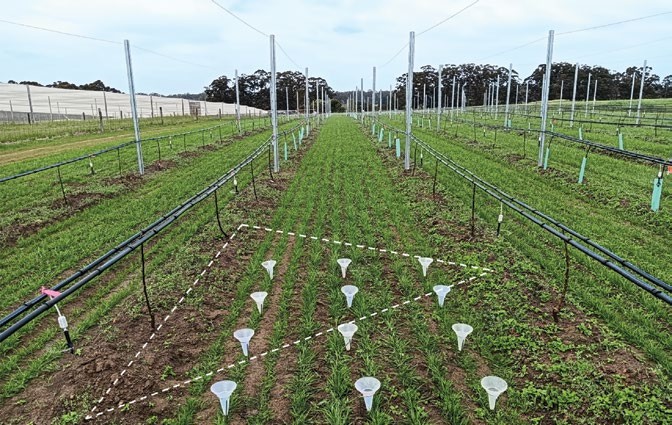BUSINESS narrow orchard systems
WA narrow
orchard systems
project update:
IRRIGATION
As part of the new 5 year national project to design and evaluate narrow orchard systems (NOS), the Department of Primary Industries and Regional Development (DPIRD) is investigating three Australian bred apples (‘ANABP 01’, ‘ANABP 09’, ‘ANABP 14’) on three different vigour rootstocks (semi-dwarfing (Geneva ® (CG) 202) and dwarfing (M26 and M9 Nic ® 29)) in 2D multileader narrow orchard systems.
Words Shuangxi Zhou and Dario Stefanelli, Scientists, Department of Primary Industries and Regional Development Research
THE orchard planted at the Manjimup Horticultural Research Institute has 2 m tree spacing and 2.5 m row spacing. This article provides information on the project’s irrigation setup for the apple trees and inter-row grass ground cover.
Irrigation setup for apple trees and inter row ground cover
Drip and sprinkler irrigation are the most common and widely used irrigation types. Drip irrigation is often viewed as more efficient and cost-effective. Drippers use less water at a lower flow rate and enable water to reach the deeper roots of tree crops. The slow flow rate of the water delivered from drippers does not overwater plants, create runoff or get carried by the wind. In the NOS project, one dripper per tree has been installed, a second dripper will be installed when the trees have grown if they require more water.
Drip irrigation is not utilised for watering inter row ground cover crops as they do not provide adequate coverage and/or the amount of water that the crop requires. Dry climate and soil conditions are common in Western Australia (WA). Drought can rapidly shut down the photosynthetic function of grass species (Zhou et al., 2013). Inter-row grass death is common in WA orchards. Sprinklers are effective and efficient in watering inter-row grasses.
For each row of the NOS orchard, a dripper pipeline for apple trees and a sprinkler pipeline for inter row ground cover crops was installed (the dripper’s flow rate is 2 L per hour, while the sprinkler flow rate is 70 L per hour). The existing pump delivers a pressure of 1.75 bar for the sprinkler pipeline, delivering a spraying radius of 2.7 m. Inter-row sprinkler spraying distribution pattern was tested with a series of measuring cups, which determined the distance between the sprinklers on each row to 4 m. The sprinklers have been placed between the two neighbouring rows in a triangle pattern, allowing an overlapped coverage between rows.
Benefits of inter row grass cover-cropping in apple orchard
Planting and maintaining grass cover on inter-rows in an apple orchard is an effective approach to help suppress weeds, limit soil erosion, enrich soil with organic matter, stimulate soil microbial activity, enhance the water-holding capacity of the orchard, improve the soil’s load-bearing capacity and thus relieve the negative effect from soil compacting and root oxygen starvation (i.e., by workers and machines).
Inter row grass cover cropping and apple trees do not compete for resources in the soil (i.e., moisture and nutrients, the deeper root system of apple trees, contributes to the utilisation of mineral nutrient (e.g., nitrogen) from deeper subsoil layers, which is not available in the shallow root system of the inter row grass cover crop.

DPIRD officers, Kevin Gardiner and Rob Carter installing irrigation for the NOS project.

Inter-row sprinkler spraying distribution pattern testing. Tree spacing is 2 m, and row spacing is 2.5 m.

Sprinklers installed every 4 m on the left pipeline along each row, with a triangle pattern between two rows. The right pipeline along each row is for drippers.
The benefits of grass cover-cropping are believed to outweigh potential disadvantages.
The cover crop used in the NOS trial is a ryegrass clover mix, selected as it germinates consistently, develops roots quickly, is resistant to foot traffic, long-lasting, and vigorous against weeds, but not competitive with apple trees or too aggressive for regular mowing. Ryegrass also suits the soil quality, the annual rainfall, and the irrigation system in the NOS trial.
Acknowledgements
Narrow orchard systems for future climates is funded through Frontiers developed by Hort Innovation, with co-investment from Agriculture Victoria, NSW Department of Primary Industries and Regional Development, South Australian Research and Development Institute, Department of Primary Industries and Regional Development WA, University of Queensland and Plant and Food Research New Zealand, Pomewest,
Tobias Industries and contributions from the Australian Government.
Reference
Zhou S, Duursma RA, Medlyn BE, Kelly JW, Prentice IC, 2013. How should we model plant responses to drought? An analysis of stomatal and non-stomatal responses to water stress. Agricultural and Forest Meteorology, 182, 204-214.